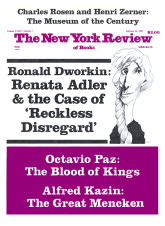In response to:
The Noble Liszt from the November 20, 1986 issue
To the Editors:
I should like to expand a point that was only touched upon in Alfred Brendel’s splendid article on Liszt. In order to arrive at a just estimate of Liszt’s contribution, we have to view him in relation to the social background against which his career unfolded. He lived at a time when the art of music was moving from the salons of the aristocracy to the public concert hall of the middle class. As the most brilliant piano virtuoso of his time, he played a central role in this process of democratization; but, a showman to his fingertips, he could not always resist the temptation to charm and dazzle his audience. Hence the occasional excesses of style and lapses in taste which the critics deplore. By dwelling only on these, they lose sight of Liszt’s extraordinary achievements.
He helped forge the harmonic and orchestral language of the nineteenth century. His symphonic poems—he was the first to use this term—and program symphonies provided a linkage between music and poetry that became one of the seminal trends within the Romantic movement. His piano compositions showed the way for the piano to transcend its natural limitations (hence the title of his “Transcendental Etudes”); the short piano pieces with evocative titles spoke to a larger public than instrumental music had ever had before. His Hungarian Rhapsodies strengthened the impulse toward musical nationalism that played such a powerful part in nineteenth century music (even if they stood closer to the rapturous improvisations of the Hungarian Gypsies than to the pure Magyar idiom uncovered a century later by Bartók and Kodály). He injected the picturesque personality—symbol of romantic individualism—into the concert hall, where it has remained ever since. He decisively influenced composers from Wagner and César Franck to Borodin, Ravel, and George Gershwin. And in his late works he anticipated the whole-tone scale and impressionistic procedures of Debussy. A man of genius, he became one of the mythic figures of a Byronic age. Those who judge him too severely tend to forget that the art of music would be immeasurably poorer if he had never lived.
Joseph Machlis
Queens College of the City University
New York City
Alfred Brendel replies:
In “The Noble Liszt,” I did not aim for a complete survey of Liszt’s achievements. Rather, I concentrated on examining the reasons that make Liszt so prone to misunderstanding and malice, on addressing topics often misunderstood, and on clearing up a few disagreements with Charles Rosen.
I am aware of Liszt’s merits as a musical poet and painter. To call him “the father of tone-painting, image-creating composers” seems to me, however, to somewhat overstate his case. Liszt merely extended, and institutionalized as “program music,” what, among others, Berlioz, Mendelssohn (in his overtures), Weber (in his Konzertstück), Beethoven (in the Pastoral symphony, and “Schlacht bei Vittoria“), and some baroque composers had done before. Last spring, I had given attention to descriptive and literary connotations of Liszt’s music in my Carnegie Hall notes on his Années de pèlerinage I and II. Incidentally, I value “Les jeux d’eaux à la villa d’Este” a great deal higher than Ms. Tureck does: while being “the model for all musical fountains that have flown ever since” (Busoni) it also presents a far less obvious, religious dimension, alien to his impressionist heirs: a quotation from Saint John reveals that it is essentially a religious piece.
On Liszt’s decisive role in breaking up tonality and classical form, I have offered my views in an essay that supplements my Philips record of late Liszt pieces (Liszt’s “Bitterness of Heart”). Among composers influenced by Liszt one could safely add to the names mentioned by Professor Machlis and Ms. Tureck those of Smetana, Saint-Saëns, Tchaikovsky (Francesca da Rimini!), Scriabin, Rachmaninoff, Strauss, Busoni, and Bartók.
If Professor Machlis insists on calling Liszt “a showman to his fingertips,” I shall not argue with him. As a pianist and writer, I have tried to make my dissenting point of view sufficiently clear. Ms. Tureck’s repeated reference to an étude she spells “Waldesrauchen” (i.e., “Forest Fumes”) suggests that, in Liszt’s landscape, a bush fire has taken place. Quickly, I have to confess to being a negligent proofreader myself: in my article, Haydn should have been branded the ingenuous (not the “ingenious”) classicist. My apologies.
This Issue
February 26, 1987



